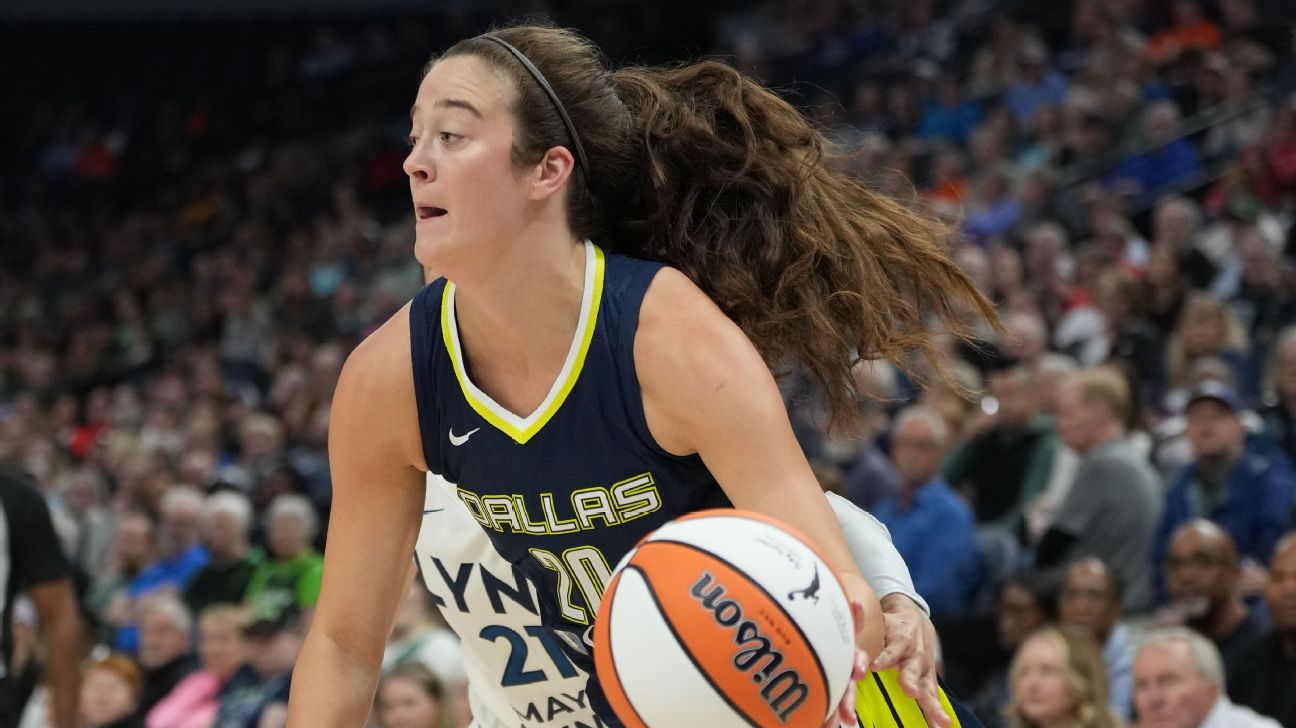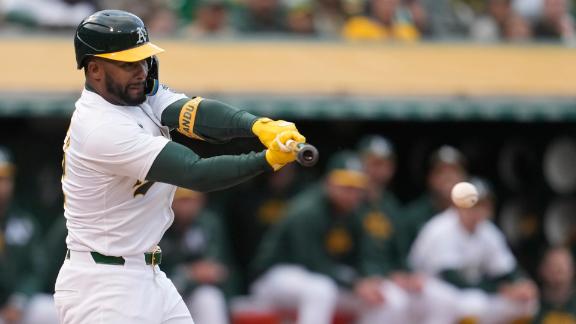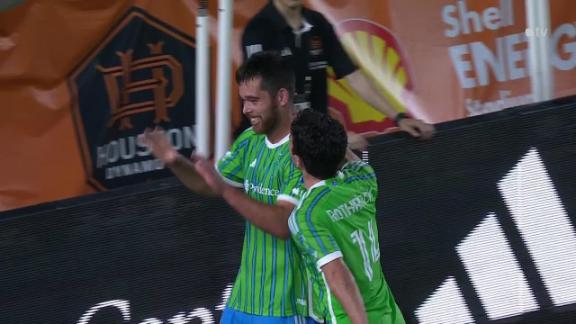![Kiley McDaniel's updated top 50 MLB prospect rankings [608x342]](https://a.espncdn.com/photo/2024/0521/mlb_top_50_prospect_rankings_16x9_608x342.jpg)
Orioles hold off Yankees 7-6 in 10 innings after Gerrit Cole makes his season debut for New York
Nearly two months into the 2024 MLB season, most of the big prospect promotions we've been waiting for have happened and many of the best young players going into the season have graduated from top 100 eligibility.
And since this is also the time of year when the conversation across the sport shifts into trade speculation, it's the perfect opportunity to update my minor league prospect rankings -- just before some of these players appear in deals over the coming months.
This list is my first update to the offseason Top 100 prospects list. You can read that intro for the parameters to be eligible, the Future Value (FV) tiers and deeper scouting reports. Players in the big leagues are eligible for this update, but players projected to lose eligibility in the next week or so are not included.
To be clear, these are those players who have graduated (or are about to) this season, taking them out of the mix for a spot: Jackson Chourio (No. 2 on my preseason Top 100), Wyatt Langford (No. 4), Evan Carter (No. 6), Jackson Merrill (No. 12), Pete Crow-Armstrong (No. 18), Masyn Winn (No. 20), Kyle Harrison (No. 36), Colt Keith (No. 40), Jordan Wicks (No. 41), Parker Meadows (No. 45), Curtis Mead (No. 47), Colton Cowser (No. 50), Jared Jones (No. 53), Brayan Rocchio (No. 79), Austin Wells (No. 82), Andy Pages (No. 87), and Joey Ortiz (No. 91).
I've also included where the top prospects in the upcoming 2024 MLB draft will slot upon being taken this summer (players listed in italics with an asterisk in these rankings), so this list can be a reference through the draft and trade deadline in July.
Now on to the top 50, along with the 10 players who just missed out.
65 FV1. Paul Skenes, RHP, Pittsburgh Pirates
My No. 2 overall prospect in the preseason Top 100, the only negative parts of Skenes' scouting report for the last year-plus have either been searching for holes (his fastball shape wasn't the best for swings and misses) or the general injury risk that comes in the "pitchers who throw hard" demographic as a whole. After his heavy innings load during LSU's College World Series run last year, Skenes was handled gently early on in pro ball and is now being unleashed in the majors.
He has already added a new pitch less than a year after going No. 1 overall as the best draft pitching prospect in more than a decade. His mid-90s splinker is a mix between a sinker and splitter that basically has no equal in the big leagues, and he has thrown it 29% of the time over his first two big league starts. Skenes was already the best pitching prospect in the sport and just invented one of the best pitches in the sport.
2. Jackson Holliday, SS, Baltimore Orioles
Holliday doesn't lose much ground here, which he shouldn't for struggling in a 10-game MLB sample -- but at the time he came up I thought expectations were too high for him, so maybe his debut served to reset expectations for his next callup. He's still above average at basically everything on the field, but probably not plus-plus at any one thing, which differs from most players who have held the No. 1 overall prospect title. On the positive side, Holliday is a left-handed shortstop who has more walks than strikeouts in Triple-A, along with above-average power, and still younger than every college player in the 2024 MLB draft class.
60 FV3. Carson Williams, SS, Tampa Bay Rays 4. James Wood, LF, Washington Nationals 5. Junior Caminero, 3B, Tampa Bay Rays 6. Coby Mayo, 3B, Baltimore Orioles 7. Jackson Jobe, RHP, Detroit Tigers 8. Colson Montgomery, SS, Chicago White Sox 9. Walker Jenkins, RF, Minnesota Twins 10. Emmanuel Rodriguez, CF, Minnesota Twins 11. Andrew Painter, RHP, Philadelphia Phillies 12. Colt Emerson, SS, Seattle Mariners 13. Jasson Dominguez, CF, New York Yankees 14. Dylan Crews, CF, Washington Nationals
I'll group the first four players together: power-hitting prospects with real defensive value who are in the upper minors and have a chance to make a splash in the big leagues this year. You could really put them in almost any order.
Williams is a plus runner and easily a plus defender at shortstop; he has a clearly plus arm and plus in-game power. The question has been about his in-zone contact, and he still hasn't improved that area much (even though his strikeout rate is down), so that's just likely to be part of his game. Wood is a fit in either center field or left field, and his home on the diamond will be dictated by what the big league team has around him, but his plus-plus raw power and patience means he has All-Star upside in either spot. Caminero has even more raw power and is a good-enough third baseman, but he still needs to curb his chase rates. Mayo is out with a fractured rib but was crushing Triple-A before the injury: 13 homers, .964 OPS in 42 games.
Jobe was the talk of spring training after hitting triple-digits for Detroit, and he is now bouncing back after command issues to start the regular season. Montgomery is good at everything at the plate, but defensively he is probably a third baseman rather than a major league shortstop. Jenkins might have the best pure hit/power/approach combination in the minor leagues, but he is probably a corner outfielder and has played only 27 pro games. He is starting a rehab assignment shortly to return from a hamstring injury he suffered in the season opener.
Rodriguez, Dominguez and Crews are all current center fielders with real power potential. Rodriguez has the best combination of power, patience and defense in the minor leagues, but has some barrel accuracy issues (like Carson Williams above), and his build and injury history suggest his defense might regress. Dominguez has begun his rehab assignment after Tommy John surgery and will likely stay in Triple-A for a bit after that. He has 30-homer upside as a potential long-term center fielder, but I'd guess he ends up more along the lines of a corner outfielder who hits 20-something homers annually. Crews, who went No. 2 overall in the draft, has bounced back after a subpar introduction to Double-A last year, but his 29% strikeout rate and lack of over-the-fence power might surprise some fans given the numbers he put up at LSU. I'm not shocked given that I had some pre-draft concerns.
Painter is a potential ace who looked to be big-league ready in March of 2023 but was shut down during that spring training and won't throw a competitive pitch until 2025 due to a PRP followed by Tommy John surgery. Emerson is the biggest arrow-up guy from the 2023 draft class and has put himself in the conversation with the top five overall picks from last summer. He continues to track like a lefty-hitting shortstop with a plus bat, plus approach and 20ish homer potential. It was announced this week that he'll miss the next 4-6 weeks with a fracture in his foot.
55 FV15. Roman Anthony, RF, Boston Red Sox 16. Samuel Basallo, C, Baltimore Orioles 17. Ethan Salas, C, San Diego Padres *Charlie Condon, 3B, Georgia 18. Christian Scott, RHP, New York Mets 19. Noah Schultz, LHP, Chicago White Sox 20. Marcelo Mayer, SS, Boston Red Sox 21. Max Clark, CF, Detroit Tigers 22. Owen Caissie, RF, Chicago Cubs *Travis Bazzana, 2B, Oregon State 23. Noelvi Marte, 3B, Cincinnati Reds 24. Jett Williams, SS, New York Mets 25. Jordan Lawlar, SS, Arizona Diamondbacks 26. Matt Shaw, 3B, Chicago Cubs 27. Brooks Lee, SS, Minnesota Twins 28. Brady House, 3B, Washington Nationals 29. Aidan Miller, SS, Philadelphia Phillies *Braden Montgomery, RF, Texas A&M *Hagen Smith, LHP, Arkansas *Chase Burns, RHP, Wake Forest 30. Jeferson Quero, C, Milwaukee Brewers 31. Sal Stewart, 3B, Cincinnati Reds 32. Cade Horton, RHP, Chicago Cubs
Anthony (just turned 20) and Basallo (will be 19 through the regular season) are both lefty-hitting prodigies already in Double-A. Basallo still chases a bit more than average and could stand to raise his launch angle a bit (as could Anthony). Both could catch fire at any moment. Mayer is in Double-A at 21 years old playing on the same team as Anthony. His game is roughly comparable to Colson Montgomery's, with Montgomery offering more hit tool and a better approach while Mayer is a better runner who projects to stick at shortstop.
Caissie and top 2024 draft prospect Condon are both 21-year-old power hitters who fit in corner positions. Caissie is a true three-outcome type (31% K, 15% BB and 22 HR last season) who is hitting well in Triple-A with gaudy exit velos but is a fringe corner outfielder. Condon is crushing the SEC. He has a bit less power, but notably better bat-to-ball ability and a chance to stick at third base.
Salas is unbelievably gifted in all phases, but he is also a 17-year-old catcher being pushed in High-A, so his slow offensive start isn't that surprising. He's roughly comparable to Clark -- another talented, young up-the-middle position player scuffling a bit in A-Ball -- though Salas outhit him at the same Low-A stop last season.
Scott has been one of the biggest risers in all of pro ball. He has plus command of three above-average pitches and has already excelled in three big league starts. Schultz has easily plus stuff and is a loose 6-foot-9 lefty who has now posted 80 strikeouts and 13 walks in 17 pro starts, posting 80 strikeouts.
Williams and Bazzana feel roughly comparable as they're both plus runners and they're both shorter than most conventional power hitters, but both have real pop. Defensively, they will probably end up at second base or center field. Bazzana is more than a year older than Williams and plays in the third-best conference in college baseball, but he gets the nod over Williams, who is playing well in Double-A, because he has more upside with plus raw power compared to Williams' solid average pop.
The other five players in this area are all upper minors/big league infielders with some questions. Marte is serving an 80-game PED suspension but showcased his standout hitting ability in a 35-game MLB audition last season. Lawlar wasn't good in his 14-game stint with the Diamondbacks last year and is blocked a bit in Arizona (he's also on the shelf now due to thumb surgery). Lawlar has been tied to Mayer as a prospect for some time; both are shortstops who went in the first 10 picks of the 2021 draft. Both have struggled in the upper minors, and their outlooks are more as solid everyday players rather than the potential superstars some envisioned on draft day.
Shaw's swing plane hasn't allowed his plus raw power to show up in games just yet, but the pieces are here for a breakout when that occurs. Lee is a passable shortstop who fits better at second or third base. He really gets the most out of his solid average hitting tools and has just started a rehab assignment after a spring training back injury.
House is having a breakthrough season in Double-A. He has eight home runs in his first 37 games, but it's his 11% walk rate that is most encouraging, especially after it was just 4% in the second half last season. His tools have always been All-Star level, and he might be rounding the corner to join the Nats' rebuild, but some scouts are still dubious. Montgomery has comparable raw power and is almost the same age as House as a junior at Texas A&M. House gets the nod between the two due to positional value, and the Double-A competition he is facing is so much better than the SEC. Montgomery looks to have more hitability though, so he could move ahead by the end of the season.
Miller was a popular pick to click from the 2023 draft's muddled group of late-first round prep position players. He was old for his class and missed most of the spring with a broken hamate bone, but also had the longest track record in the class. He's now looking passable defensively at shortstop (when many, including myself, thought he had no chance of sticking at the position at draft time) and is going off at Low-A, completely eliminating the injury and age concerns from 12 months ago. Stewart is a decent defensive third baseman and may be an even better hitter than Miller, with comparable raw power. Quero is set to miss the season after shoulder surgery. He just needs to improve his chase rate to become one of the better catchers in baseball, and he'll be a solid starter even if he doesn't.
Burns and Smith are a near coin flip, and my ranking could go either way on draft day. After diving deeper, Burns' command is better than I expected, so he isn't as reliant on his plus-plus stuff as I'd thought earlier in the season. Smith is getting absurd results, on a 2023 Skenes level, with his mid-90s heater and plus slider. Horton has above-average stuff and starter command and is in Triple-A waiting for a chance that may come in the second half.
50 FV33. Xavier Isaac, 1B, Tampa Bay Rays 34. Harry Ford, C, Seattle Mariners 35. Josue De Paula, RF, Dodgers 36. Leodalis De Vries, SS, San Diego Padres 37. Cole Young, SS, Seattle Mariners *Jac Caglianone, 1B, Florida 38. Chase DeLauter, RF, Cleveland Guardians 39. Jacob Melton, CF, Houston Astros 40. Dalton Rushing, C, Los Angeles Dodgers 41. Marco Luciano, SS, San Francisco Giants 42. Spencer Jones, CF, New York Yankees 43. Tink Hence, RHP, St. Louis Cardinals 44. Chase Dollander, RHP, Colorado Rockies 45. Rhett Lowder, RHP, Cincinnati Reds 46. Kyle Teel, C, Boston Red Sox 47. Heston Kjerstad, RF, Baltimore Orioles 48. Sebastian Walcott, SS, Texas Rangers 49. Ricky Tiedemann, LHP, Blue Jays 50. Kevin McGonigle, SS, Detroit Tigers
Isaac got more support than I was expecting for a first base-only slugger in my conversations about this ranking, but the industry seems sold on him being an impact player. It makes me wonder if he and Triston Casas having success after going in the first round out of high school will give the prep first-base demographic new life in the draft.
De Paula and De Vries don't have much in common other than being recent international signings, having last names that start with "De," and being very good at baseball. De Paula is a corner-only masher who grew up in Brooklyn before signing out of the Dominican Republic, while De Vries is a switch-hitting shortstop from the Dominican Republic who has all of the tools but has only played 11 pro games. Young and Ford are the potential shortstop and catcher of the future for Seattle, continuing to track like strong everyday players.
Caglianone, who is currently starring as a two-way player at Florida, and Walcott are two of the highest variance prospects on this list. Cags has 80-grade power and 60-grade bat control but still possesses way-below-average pitch selection and is limited to a corner defensively. Walcott would still be young among the prep players in the 2024 MLB Draft and has been pushed to High-A for some reason, but he is playing shortstop, keeping his head above water, and also has 80-grade power potential. DeLauter also fits in this group of high-variance prospects, but more due to his nagging foot issues than his inconsistent play.
Melton is trending toward a corner-outfield spot defensively, but he's a well-rounded prospect with an above-average power/speed combo. Rushing is still just a maybe-catcher but is mashing to the point that he would play regularly even if he couldn't catch. Luciano and Jones both have big-power potential. Luciano could end up as a second/third baseman who draws lots of walks and hits for power but low average while Jones is an outfield tweener who is trying to dial in his long limbs to get to his plus-plus power regularly in games.
Hence, Dollander and Lowder all continue to track as potential mid-rotation starters; Dollander has the most stuff and Lowder the best feel. Tiedemann is starting to worry scouts with his injuries and some reliever risk. Teel is continuing to look like a starting catcher with some offensive upside and Kjerstad is still probably a big league starter despite a rocky seven-game MLB audition. McGonigle is my latest gut-feel draft day breakout pick. He has an excellent feel to hit, with hopes for more power coming.
Just missedPosition players Termarr Johnson, 2B, Pittsburgh Pirates Jacob Wilson, SS, Oakland Athletics Tyler Black, 3B, Milwaukee Brewers Drew Gilbert, CF, New York Mets Jace Jung, 2B, Detroit Tigers
Pitchers Chase Petty, RHP, Cincinnati Reds Drew Thorpe, RHP, Chicago White Sox Thomas Harrington, RHP, Pittsburgh Pirates Chase Hampton, RHP, New York Yankees Carson Whisenhunt, LHP, San Francisco Giants













